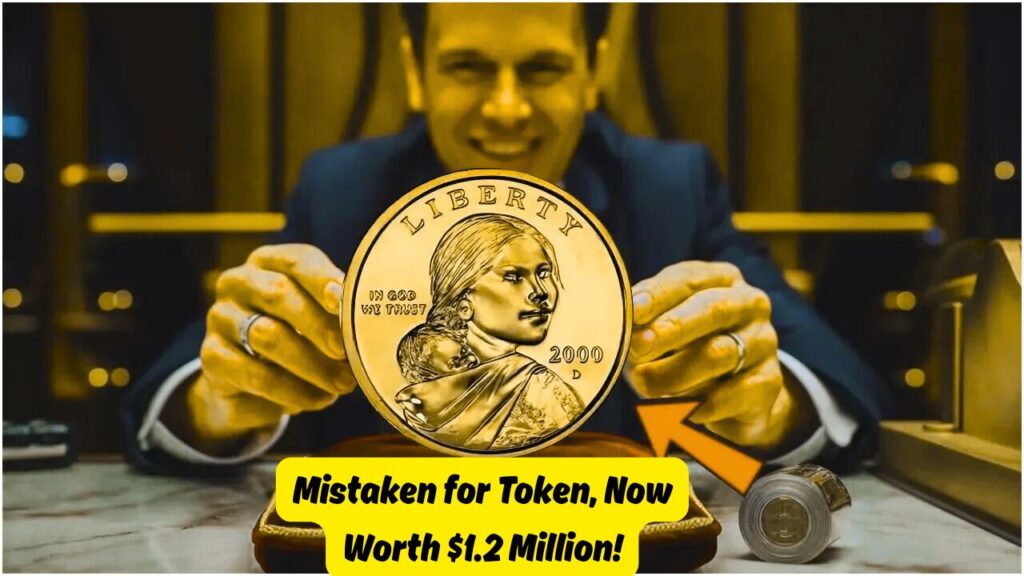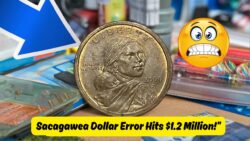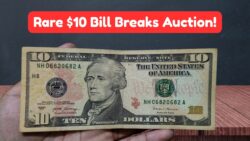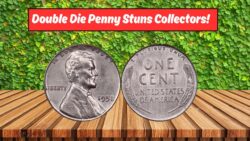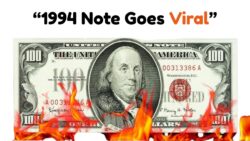$1.2 Million Sacagawea Dollar – In the world of coin collecting, few stories are as fascinating as that of the $1.2 million Sacagawea Dollar. What started as a routine minting process in the year 2000 led to the accidental creation of one of the rarest and most valuable coins in U.S. history. This coin, which at first glance resembled a mere golden token, became the center of collector frenzy after its discovery. Here’s the complete story of how this accidental masterpiece rose to fame.
The Origin of the Sacagawea Dollar
The Sacagawea Dollar was introduced in 2000 by the U.S. Mint to replace the unpopular Susan B. Anthony dollar. The coin featured a beautiful depiction of Sacagawea, the Shoshone woman who assisted Lewis and Clark on their expedition, carrying her infant son Jean Baptiste.
- Composition: A copper core with manganese-brass outer layer giving it a golden hue
- Size: Same diameter and thickness as the Susan B. Anthony dollar
- Purpose: Revive interest in the dollar coin and honor Native American contributions
Though the coin had historical significance, it failed to gain much traction in everyday commerce due to public preference for paper money.
The Rare Mule Error That Shocked Collectors
In early 2000, a curious mix-up at the U.S. Mint in Philadelphia led to an extraordinary minting error — a “mule” coin. A mule coin is one that is struck with mismatched dies — meaning the front and back do not belong to the same coin.
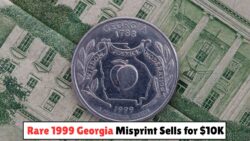 This 1999 Georgia Quarter With Misprint Just Hit $10,000 at Auction – Still in Circulation!
This 1999 Georgia Quarter With Misprint Just Hit $10,000 at Auction – Still in Circulation!
In this case:
- Obverse (front): A George Washington quarter design
- Reverse (back): The Sacagawea dollar eagle reverse
- Metal: Struck on a golden-colored dollar coin planchet
This unintentional combination of a quarter and dollar created a coin that had never been seen before.
How It Was Discovered
The first known example of the error was discovered by Frank Wallis of Arkansas in May 2000. He noticed the odd-looking coin in a roll of dollar coins from his local bank. Word quickly spread through the numismatic community, and experts confirmed the authenticity of the error.
As more examples turned up, collectors realized they had something incredibly rare on their hands. In total, only 19 authentic examples of the mule error are known to exist today.
Why It’s Worth $1.2 Million
Not all Sacagawea Dollars are worth a fortune. Most are worth face value or slightly more. But the mule error — a genuine mint mistake — is an extreme rarity. Here’s why this coin commands such a staggering price:
1. Incredibly Rare
Only 19 of these coins have been authenticated and graded by professional organizations like PCGS and NGC. This scarcity puts them in the elite category of U.S. coinage.
2. Historical Significance
It’s the first known mule error involving coins of different denominations struck for circulation by the U.S. Mint.
3. Demand from High-End Collectors
Wealthy collectors and museums aggressively bid for ultra-rare U.S. coins. In 2021, one such Sacagawea mule dollar graded MS-67 sold for $1.2 million at auction.
4. Mint-Origin Authentication
Since these were struck at the Philadelphia Mint and verified by top grading services, their provenance adds to their legitimacy and value.
Coin Design Details That Make It Unique
| Feature | Mule Error Sacagawea Dollar |
|---|---|
| Obverse Design | George Washington (from State Quarter) |
| Reverse Design | Eagle in flight (Sacagawea dollar) |
| Metal Composition | Manganese-Brass clad over copper core |
| Mint Mark | None (struck at Philadelphia Mint) |
| Diameter | 26.5 mm |
| Weight | 8.1 grams |
| Total Known Specimens | 19 |
How to Check If You Have One
Although highly unlikely, it’s worth checking your coin collection or loose change for unusual characteristics. Here’s how you can spot this error:
- Look for George Washington on the front instead of Sacagawea
- Flip the coin and check if it has the Sacagawea eagle reverse
- The coin should have a golden color (not silver like quarters)
- Take it to a reputable coin dealer or grading service for confirmation
Where the Coin Has Appeared
- Featured on Coin World magazine covers
- Exhibited at major coin shows in the U.S.
- Listed on PCGS and NGC auction result archives
- Bought by private collectors including famous numismatists
This coin has become a legend in U.S. minting history, drawing worldwide attention for its bizarre origin and exceptional value.
The Mystery Remains
Despite the hype and analysis, no one knows exactly how the mistake happened. The most accepted theory is that during production, a Washington quarter die was accidentally paired with a Sacagawea dollar die and struck on the wrong planchet. Whether it was human error or a mechanical glitch, the result was a collector’s dream.
The $1.2 million Sacagawea dollar isn’t just a coin—it’s a piece of minting history. It’s a reminder that even government institutions like the U.S. Mint can make mistakes, and sometimes, those mistakes are worth a fortune. Whether you’re a seasoned collector or just starting out, always keep an eye on your change — you never know what might be hiding in your wallet or drawer.
FAQs
Q1. What is a mule error coin?
A mule error is a coin struck with mismatched obverse and reverse dies, typically from different denominations.
Q2. How many $1.2 million Sacagawea mule coins exist?
Only 19 authenticated examples are known to exist as of now.
Q3. Are all Sacagawea dollars valuable?
No, only the mule error coins or proof errors are significantly valuable; most are worth face value.
Q4. Where can I verify if my coin is authentic?
You can send it to PCGS or NGC for grading and authentication, or visit a certified coin dealer.
Q5. How can I sell a rare coin?
You can auction it through reputable auction houses like Heritage Auctions or contact collectors via numismatic forums.

